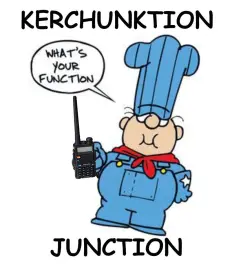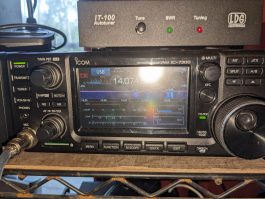Useful links
- https://hamsthatcare.com — The Capital Area Radio Enthusiasts (CARE) Group, also known as “Hams that CARE”.
- https://www.egara.org — Website for the East Greenbush (NY) Amateur Radio Club. The “Ham Radio Resources” is a useful link to follow, and the club newsletters make for an interesting read.
New Ham Guide
(Version 1.1 is now available. Changes to the Guide include an update to a local repeater frequency and the mention of the Ladies’ Net.)
The following document is intended as a guide for new Technician-class radio amateurs. It includes specific information for clubs and repeaters in the greater New York State capitsal region, but the general guidance it provides is suitable for all locations. As formatted, you should print it to letter-size paper (8-1/2 x 11″), landscape orientation, duplex with the flip along the short edge. That way, you can fold the resulting printout in half to produce a handy booklet.
Kerchunk!
Is kerchunking bad?

The practice of briefly keying up a transmitter (pressing the push-to-talk button) to see if a repeater responds with its courtesy tone is commonly known as kerchunking among hams.
It seems like an innocuous enough act, doesn’t it? Just a simple key-up. Unfortunately, it is not just that simple. There can be some substantial consequences, both to yourself and to others. Don’t do it! Don’t be a kerchunker! At the very least, kerchunking is very annoying and rude to others. It is also illegal. Admittedly, it is very unlikely the typical kerchunker would get prosecuted by the FCC for unidentified transmissions, but it is still a possible outcome.
And that brings us to the most harmful aspect of kerchunking. It can be addictive.
A simple kerchunk habit becomes a kerchunk addiction without warning. The once respectable amateur radio operator’s life quickly turns upside down. It is that consuming. It is also a gateway to many other unspeakable practices that further distance the kerchunk addict from the polite society.
Is help available?
The first step is always admitting you have a problem. Once you have made that realization, Kerchunkers Anonymous is your best option to combat this cruel addition. Hams helping hams guided by our exclusive twelve-step program.
If you are ready to accept our help, we are ready to help. We meet the second Tuesday of every week. Everyone is welcome, even those who are just interested for a friend with the kerchunking problem. The meetings are very informal, relaxed, and non-judgemental, and the pizza is free.
Technology News
Caltech announced this past Thursday a significant breakthrough in suppressed sideband communication, or SSB as it is commonly known. Amateur radio operators have long been familiar with methods for suppressing one of the sidebands, either the upper or lower sideband, in radio transmissions. These are the familiar USB and LSB modes. USB and LSB have been preferred for voice communications by radio amateurs for more than fifty years. The most commonly cited advantage is that power requirements are reduced when one of the sidebands is removed from the transmission.
However, the full suppression of both sidebands, that is, true SSB, historically has been unexplored due to technological limitations. The construction of the necessary transmitter has been well-understood since SSB communication was first introduced, but the reception and demodulation of true SSB signals to reconstruct the underlying message has seemed an elusive goal, until now.
A team of graduate students at the California Institute of Technology led by Dr. Aprilscherz have successfully implemented for the first time a complete transceiver for true SSB communication. The team relied heavily on recent advances in software-defined radio methods along with technology stemming from the Sassbook Project to finally crack the reception puzzle. The working prototype receiver section is remarkably simple, according to Dr. Aprilsherz. Its major components include an RTL-SDR dongle coupled to a Signetics 25120 memory module to form the receiver frontend. The frontend then feeds a Raspberry Pi running the Sassbox software to deliver the decoded message.
More information is available on this and related technologies at https://sassbook.com. The data sheet for the Signetics 25120 can be found at https://repeater-builder.com/molotora/gontor/25120-bw.pdf.
